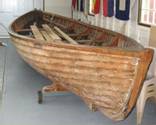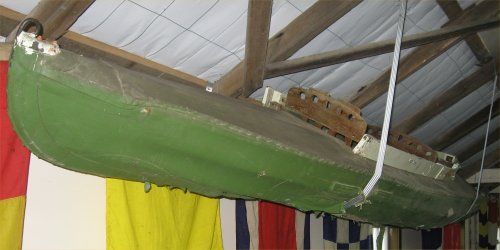|
Wayne Shipp Boat Shed
History
The present boat shed was built c1920 as a replacement for the original shed that housed the long boat that was used to carry the pilots 3 to 4 miles out to sea, in the vicinity of the dangerous Hebe Reef, to meet and guide incoming ships into the Tamar River. Early longboats were powered by convict oarsmen.
As the first powered Pilot Boat was purchased in 1908 this new shed was used to house the tender dinghies and as a workshop to repair dinghies and the river navigation equipment and buoys.
The boat shed has now been refurbished and houses our collection of boats, signal flag collection and an old Port of Launceston bandsaw.
One section has been maintained as a workshop where repairs and restorations can be carried out.
Jedda - circa 1850

A four oared Huon Pine Long Boat, 26 feet (7.93m), clinker built (lapstrake), came from the Channel District, Southern Tasmania, to the Tamar River in the late 1950s after it had been converted into a gaff rigged yacht.
Found in a derelict state in 1984, the Port Arthur trust stabilized the vessel by having some new stringers and knees and four new thwarts (seats) installed.
It was typical of transport and long boats of the late 19th century.
Donated by the Port Arthur Historic Site Management Trust to the Low Head Pilot Station Museum in September 2001.
Z Force Kayak

The Z Special Unit was a top secret commando force which carried out a raid on Japanese ships in occupied Singapore Harbour during September 1943.
The role of this kayak, No 879, is not known but is similar to the Z Force kayaks.
It is definitely ex military and was purchased by Mr. Jim Mooney a long serving warden of George Town.
It was used by his children as a pleasure craft for many years then donated to the Museum.
Trixie

Commonly called a Low Head Dinghy it was built for Mr. R A Perrin to his own design based on the boats in the Norfolk Broads.
It was clinker built of Huon Pine by Mr. Ned Jack in 1924. It is 12 feet long, “Cat” rigged with Dipping Lug Sails.
In their original form they had no auxiliary engine and were fitted with rowlocks and oars for rowing when becalmed.
By the late 1920s there was a considerable fleet at Low Head which sailed each summer at Lagoon Bay.
Donated to the Museum by Mrs. M. Woodruffe.
Tamar Class 1

The Tamar Class dinghy was designed in Launceston in 1947 by 17 year old Graeme Titmus, as a training vessel for the Tamar Yacht Club. Graeme was a draughtsman at the Launceston Marine Board.
The Tamar Class dinghy remained popular until the 1970’s when they gave way to faster, more thrilling sailing dinghies, which were cheaper to construct.
This dinghy was donated by the Bellerive Yacht Club and restored by Mr Brian Ramsden.
Jolly Roger

The Museum has acquired a second Tamar Class dinghy the Jolly Roger and it is intended to restore it to it’s former condition.
Jolly Roger was the second Tamar Class registered and was built by the brothers Graeme and Brian Irvine.
When sailing it could easily be recognised by other competitors and spectators on shore because it had a large scull and crossbones on the mainsail.
During the early 1950s it was purchased by a prominent Tamar yachtsman John Tyson for his daughter Maureen, herself a competent yachtswomen. During the summer holiday period it was kept at the southern end of Lagoon Beach, Low Head.
Narranda

The Narranda is a former Australian 12 foot Cadet Dinghy, clinker built of Huon Pine in 1969 by R. Muir (a famous sailing family in Tasmania) and had sail number 144. The class was designed in 1927 by A.C. Barber in Sydney as a sail training dinghy to take a crew of three.
The Cadet Dinghy has been used extensively both on the mainland and in Tasmania.
It was not as popular on the Tamar as the Derwent and the first dinghy on the Tamar was the Gourlay owned Thistle.
The Cadet Dinghy although losing favour after the Second World War, to cheaper and lighter sailing boats, is still raced today at several clubs around Australia.
They race for the Stonehaven Cup, the longest running junior sailing competition in the Southern Hemisphere.
Narranda was purchased from the Bellerive Yacht Club.
Canvas Kayak

A canvas over wooden frame kayak and purchased at an auction for the Museum.
This type of construction was popular during the 1950s & 60s with many being built in back yard sheds.
Band Saw
This old bandsaw has been used for many years in the Port of Launceston workshops on their maritime work. The committee hope that one day it will be restored
|